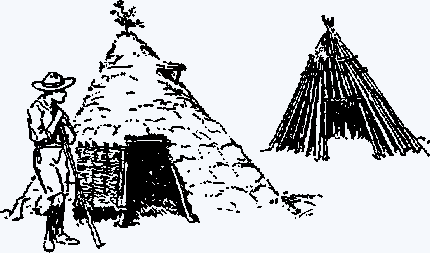CAMP LIFE
Camp Fire Yarn No. 8
PIONEERING
Knot Tying • Hut-Building • Felling Trees • Bridging
Self-Measurement
• Judging Heights and Distances
Pioneers are men who go ahead to open a way in the jungle or elsewhere for those coming
after them.
When I was on service on the West Coast of Africa, I had command of a large force of local
scouts, and, like all scouts, we tried to make ourselves useful in every way to our main army, which was coming along behind
us. We not only looked out for the enemy and watched his moves, but we also did what we could to improve the road for our
own army, since it was merely a narrow track through thick jungle and swamps. So we became pioneers as well as scouts. In
the course of our march we built nearly two hundred bridges over streams, by tying poles together.
But when I first set the scouts to do this important work I found that, out of the thousand
men, a great many did not know how to use an axe to cut down trees, and, except one company of about sixty men, none knew
how to make knots - not even bad knots.
SAVING LIFE WITH KNOTS
Just before I arrived in Canada a number of years ago, an awful tragedy had happened at
the Niagara Falls.
It was mid-winter. Three people, a man and his wife and a boy of seventeen, were walking
across a bridge which the ice had formed over the rushing river under the falls, when it suddenly began to crack and to break
up. The man and his wife found themselves on one floe of ice floating away from the main part, and the boy was on another.
All around them the water was covered with similar floating blocks of ice, grinding and
bumping against each other. The three people were at the mercy of the current, which here moved slowly, but gradually and
surely carried them downstream towards the awful rapids a mile away.
People on the banks saw their dangerous position, and thousands collected, but not one
seemed able to do anything to help them. Swimming was impossible. So was a boat rescue.
For an hour the poor wretches floated along. Then the river carried them under two bridges,
which span the river just before the rapids.
On the bridges, 160 feet above the water, men had lowered ropes so that they hung down
in the path of the drifting people.
As they passed by, the boy managed to grasp a rope, and willing hands proceeded to haul
him up. But when they had him up about half-way, the poor fellow could hold on no longer. He fell down in the icy stream,
and was never seen again.
The man on the other floe also grasped a rope which he tried to fasten around his wife,
so that she, at any rate, might be saved. But the current was now rushing them along. His hands were numb. He failed to fasten
the rope. It slipped from his hands.
And a few seconds later both he and his wife ended their tortures by being sucked under
the water in the heavy swirling rapids.
What Would You Have Done?
It is easy to be wise after an event, but this disaster is worth thinking out. What would
you have done had you been there ?
One of our Canadian Scoutmasters told me that he was travelling in a train shortly after
this accident, when some of his fellow-travellers were talking it over. They did not know that he was connected with the Scouts
in any way, and one of them said:
"Well, I believe that if any Boy Scouts had been there they would have found some plan
for saving those poor people."
People often think: "What is the good of learning such a simple thing as tying knots ?"
Well, here was a case in which that knowledge might have saved three lives.
When the ropes were lowered from the bridge they should have had a loop or two tied in
them for the victims to put around themselves, or to put their arms or legs through. As it was, the ropes had no loops, and
the people, not knowing how to tie bowlines or any other type of loop, were unable to save themselves.

USEFUL KNOTS
Every Scout ought to be able to tie knots.
To tie a knot seems a simple thing, and yet there are right ways and wrong ways of doing
it, and Scouts ought to know the right way. A life may depend on a knot being properly tied.
The right kind of knot to tie is one which you can be certain will hold under any amount
of strain, and which you can undo easily if you wish to.
A bad knot is one which slips when a hard pull comes on it, or which gets jammed so tight
that you cannot untie it.
The best way to learn is to get a fellow who knows to show you. You need to practise a
lot, or you will soon forget the knots. Use pieces of rope or cord and not messy bits of string or bootlaces!
On pages 74 and 75 are useful knots which every Scout ought to know, and ought to use
whenever he is tyine '.tring or rope.
To prevent the end of a rope from becoming frayed and unlaid you should whip it. This
is done by wrapping thin string round it several times and finishing it off so that the ends do not show. There are several
methods of doing this; the picture on this page shows an easy and efficient way.
We had no rope with us in West Africa, so we used strong creeping plants, and thin withes
or long whippy sticks, which we made still more pliant or bendable by holding one end under foot and twisting the other round
and round with our hands. Willow and hazel make good withes. You cannot tie all knots with them, as with rope, but you can
generally make a timber hitch.
HUT BUILDING
To live comfortably in camp a Scout must know how to make a bivouac shelter for the night,
or a hut if he is going to be in camp for a long time.
What sort of shelter you put up depends on the country and weather.
Notice the direction from which the wind generally blows, and put the back of your shelter
that way, with your fire in front of it. If you are going into camp where there are plenty of trees, and you have got the
right to use them, then there are several types of shelters you may make.
A bivouac shelter is the simplest form of hut. Two upright stakes are driven firmly into
the ground, with a ridge-pole placed in position along the tops. Against this a number of poles are made to lean from the
windward side, with crossbars to support the branches, reeds, sods or twigs, or whatever is to form your roofing material.

For a single man this shelter can be made quite small, about 3 ft. high in front, 3 ft.
wide and 6 ft. long. You build your fire about 4 ft. in front of the shelter, and lie in it alongside your fire.
If the "shack" is for more than one man, you build it 5 ft. or 6 ft. high in front, and
6 to 7 ft. deep, so that several fellows can lie alongside each other, feet to the fire.
Thatching Your Hut
When you start to thatch your framework, begin at the bottom and lay your roofing material
in layers, one above the other in the way that slates are put on a roof. In this way you make it watertight.
For thatching you can use thick evergreen branches, or grass, reeds, sods, bark or slabs
of wood (called "shingles"), or small twigs of heather clasely woven in.
It is generally advisable to lay a few branches and stout poles over the thatch when finished
in order to keep it on if a gale springs up.
Other Huts
If you want to build a complete hut, you can make a lean-to from each side on the same
ridge-pole. But the single lean-to, with its fire in front of it, is quite good enough for most people.
Another way to build a shelter hut is to lean a ridge-pole or backbone from the ground
into the fork of a small tree about 5 ft. above the ground, the butt of the pole being about 7 ft. to windward of the tree.
Then put up a side pole leaning against this, and roof over in the same way as for a lean-to.

Where you have no poles available you can do as the South African natives do-pile up a
lot of brushwood, heather, etc., into a small wall made in a semicircle to keep out the cold wind-and make your fire in the
open part.
Zulus make their huts by planting a circle of long sticks upright in the ground. They
then bend the tops towards the centre and tie them together. Next they weave whippy sticks horizontally in and out among the
uprights until they have made a kind of circular birdcage. This they cover with a straw mat, or thatch it, or weave straw
in among the sticks. Sometimes a small hole is left at the top, to act as a chimney.

The Red Indians make their "teepee" by tying several long poles together in the form of
a pyramid, and covering them with canvas or skins sewn together.

If your tent or hut is too hot in the sun, put blankets or more straw over the top. The
thicker the roof, the cooler the tent is in summer. If the hut is too cold, make the bottom of the walls thicker, or build
a small wall of sods about a foot high round the base of the wall outside.
Never forget to dig a drain all round your hut, so that if heavy rain comes in the night
your floor will not get flooded from outside.
YOUR AXE
A backwoodsman has to be pretty useful with his axe. To become a good axeman a fellow
must know, first, how the thing ought to be done, and secondly, he must have lots of practice in doing it before he can be
considered any good.
Only bad workmen complain of the tools-so before starting to work, be sure that your tool
is a good one.
Sharpening the Axe
Then see that your axe is sharp-really sharp, not merely with a good edge on it. A slightly
blunt axe is no more good for cutting down a tree than a very blunt knife is for cutting a pencil. Learn how to sharpen your
axe on a grindstone, while you are in civilization, where grindstones can be found and where there are men to show you.

In India, when we went "pig sticking" (that is, hunting wild boar with spears), we found
how very necessary it was to keep our spears as sharp as razors. Every time we killed a boar we sharpened up our spear-heads
again, ready for the next fight. We could not carry grindstones about with us, but we carried a small, fine file, with which
we were able to touch up the edge.
Many an old backwoodsman carries such a file with him to keep his axe keen. There is a
saying with these men that "You may lend your last dollar to a friend, but never lend him your axe-unless you know that he
is a good axeman and will not blunt it".
Protect Your Axe
Only a fool will go banging about with an axe-hacking at trees, chopping at roots and
branches on the ground, in this way destroying valuable trees and at the same time blunting the axe at every stroke on earth
and stones. And when his arms tire, he will throw the axe down, leaving it lying around on the ground, where it may catch
and cut the toe of someone moving about after dark.
When you want to leave your axe, strike straight down with it into a tree stump, and leave
it sticking there till required again, or make a special "mask" for the blade of a piece of wood, or put it in its leather
case.
Using the Axe
In using the axe, the "tenderfoot" generally tries to cover his bad aim by the extra strength
of his blows. If an old hand is looking on, he is smiling to himself and thinking of the backache he got himself the first
time that he did it.
Don't try to put force into the blow, merely be careful about aiming it so that it falls
exactly where you want it. The swing and weight of the axe will do the rest. Make the blows at a slant, not straight down.
A good axeman uses his axe equally well left-handed or right. It is all a matter of practice.
Tree Felling
When you want to fell a tree for a useful purpose, get permission first. Before starting
to fell your tree, first clear away all branches which might interfere with the swing of your axe and therefore spoil your
aim. Also clear away any brambles or undergrowth that might trip you at the critical moment. Make sure that onlookers are
well away from you.
The way to fell a tree is first to cut a big chunk out on the side to which you want the
tree to fall, and then to cut into the opposite side to fell it. Plan your work so that the tree will fall clear of other
trees and not get hung up in their branches.
Begin your first notch, or "kerf", as it is called, by chopping two marks, the upper one
at a distance above the other equal to the thickness of the tree. Then cut alternately, first a horizontal cut at the lower
mark, then a sideways, downward cut at the upper one, and jerk out the chunk between the two. Go on doing this till you get
to the centre of the tree.

Now go to the opposite side of the tree and cut another kerf here, only about three inches
above the level of the lower mark of the first kerf.
Cut out chunks when you are at it-not a lot of little chips, which are signs to anyone
coming there later that a "tenderfoot" has been at work. It is all a matter of aiming your stroke well.
Then, when your tree falls, look out for the butt. This often jumps back from the stump.
Never stand directly behind it-many a tenderfoot has been killed that way. When the stem cracks and the tree begins to topple
over, move forward in the direction of the fall, and at the same time outwards, away from the butt.
Trimming and Logging
When the tree is down, it must be trimmed, that is, the boughs and branches must be cut
off, leaving a clean trunk. This is done by working from the butt end of the trunk towards the top. Cut off each bough from
below, as close to the trunk as possible. The trunk is then cut into lengths. This is called "logging". Cut from one side
towards the middle, making the kerf half as wide as the tree is thick. Then turn the tree over and make a similar kerf from
the other side, until the logs come apart.
BRIDGE BUILDING
As I told you before, my scouts in Ashanti, when also acting as pioneers, had to build
nearly two hundred bridges. And they had to make them out of any kind of material that they could find on the spot.
There are many ways of making bridges.
Pioneer bridges are generally made by lashing poles together.
In the Himalaya mountains, they make bridges out of three ropes stretched across the river
and connected together every few yards by V-shaped sticks, so that one rope forms the footpath and the other two make the
handrail on either side. They are a jumpy kind of bridge to walk across. But they take you over and they are easily made.
The simplest way for bridging a narrow, deep stream is to fell a tree, or two trees side
by side, on the bank, so that they fall across the stream. With an adze you then flatten the top side. Put up a handrail,
and there you have a very good bridge.

Rafts, too, can be used to cross a stream. Build your raft alongside the bank-in the water,
if the river is shallow; on the bank if it is deep. When the raft is finished, hold on to the down-stream end, push the other
out from the bank, and let the stream carry it down into position.
To make a Ladder with a Pole-Tie sticks firmly across the pole at intervals to form steps.
A pole can be made by tying several Scouts' staffs together.
SELF MEASURES
Every pioneer should know his exact personal measurement in the following details, of
which I give the average man's measure:
Nail joint of forefinger, or breadth of thumb . .1 inch
Span of thumb and forefinger.
.8 inches
Span of thumb and little finger. .9 inches
Wrist to elbow (this also gives you the length of your foot). .10
inches
Elbow to tip of forefinger (called "cubit"). .17 inches
Middle of kneecap to ground. .18 inches
Extended arms, from finger-tip to finger-tip, nearly equals your height.
Pulse beats about 75 times a minute. Each beat is a little quicker than a second.
Step: a step is about 30 inches; about 120 steps equal 100 yards.
Fast walking steps are shorter than slow ones. When walking fast you walk a mile in 16
minutes, or nearly four miles an hour.
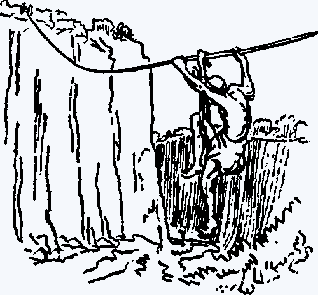
JUDGING DISTANCES
Every Scout should be able to judge distance from an inch up to a mile and more.
If you remember your self measures accurately, they are a great help to you in measuring
things. Also it is useful to cut notches in your staff, showing such measurements as one inch, six inches, one foot and one
yard. These you can measure off with a tape measure before you use your staff.
Judging the distance of a journey is generally done by seeing how long you have been travelling,
and at what rate. Suppose you walk at the rate of four miles an hour. If you have been walking for an hour and a half you
know that you have done about six miles.
Distance can also be judged by sound. If you see a gun fired in the distance and you count
the number of seconds between the flash and the sound of the explosion reaching you, you will be able to tell how far off
you are from the gun, Sound travels at the rate of 365 yards in a second-as many yards as there are days in the year.
Test the following from your own observations.
At 50 yards, the mouth and eyes of a person can be clearly seen. At 100 yards, eyes appear
as dots. At 200 yards, buttons and details of uniform can still be seen. At 300 yards, the face can be seen. At 400 yards,
the movement of the legs can be seen. At 500 yards the colour of the uniform can be seen.

For distances over these, think out for yourself which point is half-way to the object.
Estimate how far this may be from you, and then double it to obtain the distance. Another way is to estimate the farthest
distance that the object can be away, and the very nearest it could be, and strike a mean between the two.
Objects appear nearer than they really are when the light is bright and shining
on the object; when looking across water or snow; when looking uphill or down. Objects appear farther off when in the
shade; when across a valley; when the background is of the same colour; when the observer is lying down or kneeling; when
there is a heat haze over the ground.
Distances Across a River
The way to estimate the distance across a river is to notice an object X, such as a tree
or rock, on the bank opposite to where you stand at A (see diagram). Start off at right angles to A X, and walk, say, ninety
yards along your bank. On arriving at sixty yards, plant a stick or stone, B. On arriving at C, thirty yards beyond B and
ninety from the start at A, turn at right angles and walk inland, counting your steps until you bring the stick and the distant
tree in line. The number of steps you have taken from the bank, C D, will then give you the half distance across A X.
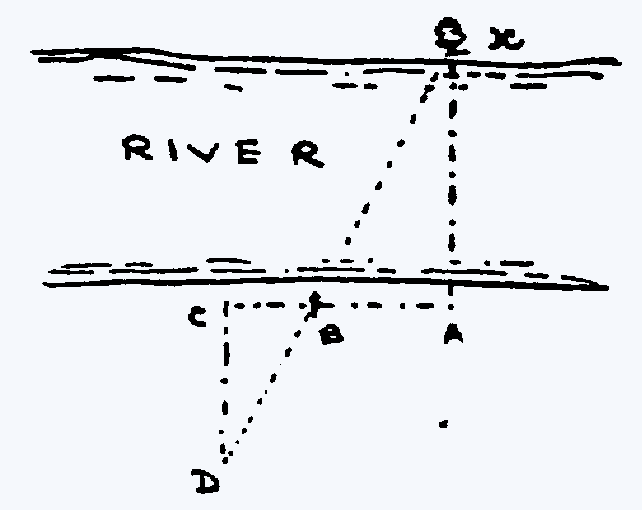
ESTIMATING HEIGHTS
A Scout must also be able to estimate heights, from a few inches up to three thousand
feet or more. He ought to be able to judge the height of a fence, the depth of a ditch, or the height of an embankment, of
a house, tree, tower, hill, or mountain. It is easy to do when you have practised it a few times, but it is very difficult
to teach it by book.
To find the height of an object, such as a tree or house, walk a distance of eleven feet
or yards or any unit you like and set up a staff with another Scout to hold it. Now walk one more unit of your chosen measurement,
making twelve in all. Get your eye down to ground level at this spot and look up at the tree. The second Scout then slides
his hand up or down the staff until your eye, his hand, and the top of the tree are all in line. Measure the distance in inches
along the staff from the ground to the Scout's hand; call these inches feet, and that is the height of the object in feet.
You can use any unit of measurement you find suitable as long as you make it eleven to one, and you call inches on the staff,
feet.
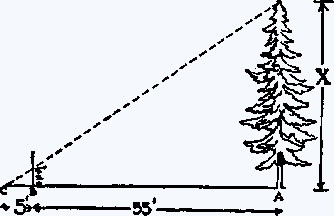
WEIGHTS AND NUMBERS
You should also know how to estimate weights-a letter of an ounce, or a fish or a potato
of one pound, or a sack of bran, and also the probable weight of a man from his appearance. These, again, are only learnt
by practice. Learn also to judge numbers-to tell at a glance approximately how many people are in a crowd, or on a
bus, or in a big crowd; how many sheep in a flock; how many marbles on a tray, and so on. You can practise for yourself at
all times in the street or field.
PATROL PRACTICES IN PIONEERING
Practise knot tying against time, by having races between the Scouts in pairs. The losers
pair off again for further races, until the slowest knot tier is found. In this way (which can be used for practice in other
Scoutcrafts also), the worst performers get the most practice -and the competition is just as great to avoid being the worst
as it would be in striving to be the best, and win a prize.
Knot tying races in the dark are fun. The Patrol Leader turns out the lights for a few
seconds after naming the knot to be tied. Instead of turning off the lights, the competitors may be blindfolded.
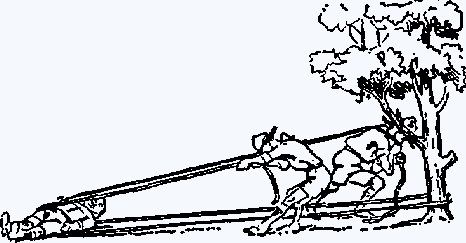
Make models of bridges with Scout staffs, tying them together with cord or rope.
GAME
Scout Pace
The umpire stations three individuals or groups, each group differently clothed as far
as possible, and carrying different articles (such as stick, bundle, paper, etc.), at distances from 300 to 1,200 yards from
starting-point. If there are other people about, these groups might be told to kneel on one knee, or take up some such position
to distinguish them from passers-by. The umpire makes out a circular course of three points for the competitors to run, say,
about 1/4 mile, with a few jumps if possible.
The competitors start and run to No. 1 point. Here the umpire tells them the compass-direction
of the group they have to report on. Each competitor on seeing this group writes a report showing-
-
How many in the group.
-
How clothed or how distinguishable.
-
Position as regards any landmark near them.
-
Estimation of distance from his own position.
He then runs to the next point and repeats the same on another group, and so on; and finally
he runs with his report to the winning post.

Marks-Full marks, 5 for each correct and complete description of a group-that is, an aggregate
of 15 marks for the course. One mark deducted for every ten seconds later than the first boy handing in his report at the
winning post. Marks or half-marks deducted for mistakes or omissions in reports.
